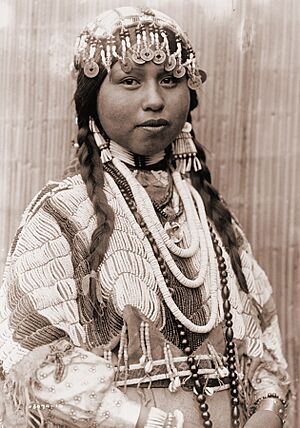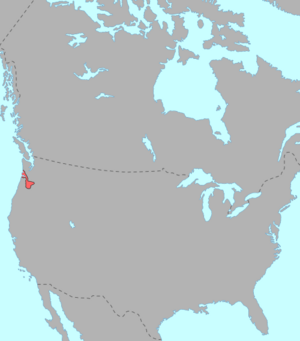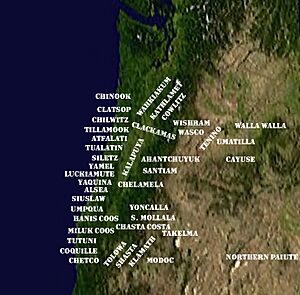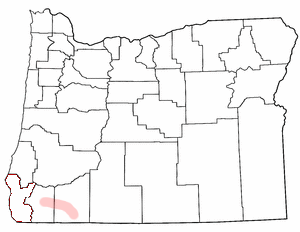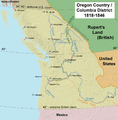Native American peoples of Oregon facts for kids
The Native American peoples of Oregon are the original groups of people who have lived in the area now known as Oregon for thousands of years. Today, the state of Oregon works with nine federally recognized Native American groups. However, in the past, there were many more independent tribal groups. Some of these groups no longer exist, while others have joined together to form the larger tribes we know today. Six of the nine tribes got their federal recognition back in the late 1900s, after a time when the government tried to end their special status and treaty rights, starting in the 1950s.
Contents
- History of Oregon's Native Peoples
- Native Americans in Oregon Today
- Population Data
- See also
- Images for kids
History of Oregon's Native Peoples
Early Explorers and Fur Traders
Before Europeans and Americans arrived, Native American groups in Oregon did not have a written language. So, we learn about their history from the journals of early visitors and traders. These early writings sometimes show misunderstandings or negative views of the Native peoples.
The Lewis and Clark Expedition traveled through Oregon from 1804 to 1806, mostly along the Columbia River. They were the first white Americans to live among Oregon's tribes for a longer period. They wrote detailed notes about the people they met, giving us the first written records of Oregon's Native population.
Lewis and Clark met different groups of Chinook people, who spoke various dialects of the Chinookan languages. These included the Kathlamet, Wasco and Wishram, Clatsop, and Clackamas tribes. At that time, Lewis and Clark thought there were about 16,000 Chinook people. The total Native population in the Oregon Country might have been around 50,000.
After Lewis and Clark left, fur traders came to the region, especially looking for beaver pelts. Ross Cox, a fur trader, arrived at Fort Astoria in 1812. He wrote about the tensions between Native people and traders, often due to attempts to steal supplies. Sometimes, these situations led to violence.
Cox described the Chinook-speaking people he met. He noted their unique appearances, like pierced ears and noses with beads. Despite his personal feelings, Cox and his group visited many tribal villages near the Columbia River. He said that "the natives generally received us with friendship and hospitality." He found the Kathlamets "most tranquil," the Tillamook "most roguish," and the Clatsops "most honest." He also noted the Chilwitz people's custom of flattening infants' foreheads, which he found unusual.
As they traveled up the Columbia River, the traders often traded tobacco and small gifts for salmon with the Native people. However, they sometimes faced problems with theft, especially when carrying goods around rapids. These incidents sometimes led to conflicts, including armed standoffs.
Further inland, Cox met other tribes, some of whom rode horses. He described these horsemen as "clean" and "bold." He also noted that there had been recent wars between the horse-riding tribes and those who traveled on foot. He found the Walla Walla people to be "decidedly the most friendly tribe."
Missionaries Arrive in Oregon
In the early 1800s, many white Americans in the East saw the Oregon Country as empty land, even though Native peoples had lived there for centuries. In 1828, Hall J. Kelley, who wanted white people to settle in Oregon, called it "the most valuable of all the unoccupied parts of the earth."
Settlement by European-Americans began in 1829 with the founding of Oregon City by John McLoughlin of the Hudson's Bay Company.
These new settlers brought diseases like smallpox and measles. Native populations had no protection against these illnesses. Between 1824 and 1829, waves of disease killed tens of thousands of Native people. Some observers believed that 80% of the Native population died in just one summer. Many villages became empty, and the few survivors often joined other tribes.
In 1838, U.S. Senator Lewis F. Linn proposed a law to claim the Oregon Country for the United States. This law would set up a fort on the Columbia River and put the area under U.S. military rule and tax laws. This set the stage for conflicts between the U.S. government and the Native peoples who already lived there.
Missionaries, like the Methodist Jason Lee, were among the first European-Americans to settle. In 1839, Lee started a large "Indian church" at The Dalles to convert the Klickitat tribe to Christianity. Lee and his group traveled among the Native people, who were often open to new ideas.
However, the diseases brought by Europeans had already greatly reduced the Native population. Lee's group found that the population in the area they visited had dropped to fewer than 375 people. They believed these survivors would not live much longer, so they stopped their plans for a new mission in the Umpqua River valley.
The Methodists still had big plans for the territory. They built a lumber mill and a "manual-labor school" to teach Native people new skills. In 1841, they built a large school near today's city of Salem for Native children. However, it closed after nine months because it wasn't successful.
More European-American immigrants arrived, and Oregon City grew quickly. Jason Lee asked the federal government to appoint an Indian Agent for the Oregon Country. Elijah White was appointed in 1842.
Soon after, relations between white settlers and Native peoples worsened. Members of the Cayuse tribe burned a mill at the Waiilatpu mission. Rumors spread that Native tribes were uniting to attack the white community. An armed group of Americans and a British representative set out to end this perceived threat. Indian Agent White met with the Nez Perce and Cayuse tribes. He forced them to choose head chiefs and sub-chiefs, holding them responsible for their people's actions.
Racism and Violence Against Native Peoples
As settlers moved into the Oregon Country, they often brought racist ideas about the Native peoples. By the late 1840s, over 9,000 American and foreign settlers lived in the Oregon Territory. Some white settlers committed violent acts to force Native communities off their land or destroy them. In 1849, someone burned a Native American village in Linn City, destroying their winter food.
The violence was not just about property. John Beeson, a settler who arrived in Oregon in 1853, was shocked by the abuse Native people suffered. He left Oregon after three years to write a book about it.
Many settlers held extreme views, even saying that all Native Americans should be destroyed. A common, cruel joke was that if a white man saw a Native man and a deer at the same time, he should shoot the man and let the deer go.
The Rogue River War (1855–1856)
The Native peoples of Southern Oregon were terrified by the brutal actions of white miners and settlers. Their pleas for protection from white authorities were ignored.
In the summer of 1855, an anonymous letter appeared in the Oregon Statesman newspaper. It warned of upcoming massacres by "Red Skins" against white settlers. This led to a meeting where a call was made to raise 3,000 troops to fight the Native people. A strong desire for war spread across the Oregon Territory, with newspapers supporting the idea.
Governor George Law Curry declared war, urging a volunteer militia to fight immediately. Extreme violence followed. Native people were forced from their villages, driven through the countryside, and many were killed. For example, 27 Native people were killed by settlers in October during a village raid. Native Americans retaliated by burning a white home and killing 27 settlers. Those who wanted the war to continue used this as a reason to keep fighting.
John Beeson, who saw the Rogue River War, later wrote: "During the years of 1855-6, as many as twenty murders were committed by the Indians; and several of them were prosecuted and hung according to law. But no account was kept of murdered Indians; and yet it was a matter of common talk, that they were shot whenever it could be done with safety to the shooter."
Newspapers at the time spread ideas that justified the war. One paper wrote in November 1855 that Native Americans were "ignorant, abject, and debased by nature" and that "God has sent us to destroy them."
The war ended in June 1856. About 100 Rogue River Native Americans were killed, and 94 soldiers, militia, or settlers died. After the war, the Tolowa people and other tribes were forced to move to reservations.
Loss of Land and the Reservation System
The Oregon Donation Land Act, from 1850 to 1855, gave white male settlers 320 acres of land in Oregon. This law also made land claims by earlier settlers legal. It even applied to "American half-breed Indians" who claimed land. This act came into effect before any treaties were made with Oregon's Native peoples. This meant white settlers could claim land already lived on by Native American tribes. Over 2.5 million acres were claimed, leading to more conflicts and "race wars," like the Rogue River Wars.
However, the U.S. had agreed with England to respect the land rights of Native peoples in the Oregon Territory. So, the U.S. legally couldn't allow settlement without making treaties to get land from the tribes. To get around this, Congress passed the Indian Treaty Act in the same year. This act allowed officials to negotiate land treaties and possibly move Native American tribes.
In the next decade, many treaties were signed with Native groups across Oregon. These included the Warm Springs and Wasco tribes (1855), the Siletz (1855), the Cow Creek band (1853), the Umatilla (1855), and the Kalapuya (1855). Some tribes in the Willamette Valley initially kept their land rights, but those treaties were never approved by the U.S. government. Later talks led to these Willamette Valley tribes joining together and being moved to a reservation.
Many tribes were forced to move to reservations, such as the Warm Springs Reservation, the Umatilla Reservation, and the Coast Indian Reservation. The Coast Indian Reservation was soon changed, losing much of its land and being divided into the Grand Ronde and Siletz Reservations.
The Termination Era
The "Termination Era" in the mid-1900s saw the U.S. government end its official recognition of over 100 Native tribes, mostly in the western United States. In the 1950s, Oregon tribes quickly lost their legal rights and federal recognition. The U.S. government stopped being responsible for Native nations, even though these responsibilities were guaranteed by treaties.
Public Law 280
In 1953, Public Law 280 was passed by the U.S. Congress. This law meant that several Native nations in Oregon and four other states lost their sole legal control over their own lands. State law enforcement took over the power to handle certain crimes involving tribal members or crimes that happened on tribal land. However, the Burns Paiute Tribe, the Confederated Tribes of Warm Springs, and the Confederated Tribes of the Umatilla Reservation are not affected by this law.
Klamath Termination Act
Public Law 587, passed in 1954, ended the special relationship between the Klamath tribe, the Modoc tribe, the Yahooskin Band of Snake Indians, and the U.S. government. It started the process of moving control of Native lands from the federal government to private owners.
The Klamath Tribes were "terminated" partly because the federal government thought they were ready to manage their own affairs and fit into American society. At the time, a thriving lumber industry on Klamath lands had made the tribe wealthy. The government believed that selling the Klamath's timberlands and giving the money to tribal members would help them become individually wealthy and independent from federal oversight.
An official noted that the Klamath Tribe had "attained sufficient skill and ability to manage their own affairs." He said they had mixed with non-Native neighbors, had a good standard of living, lived in modern homes, and used modern farm equipment. He considered them "one of the most advanced Indian groups."
As reservation lands were divided and sold, more than three-quarters of Klamath tribal members chose to receive their share in cash. The remaining members chose to keep their land in trust, but eventually, this land was also sold, and all tribal members received payments. However, the act stated that the Klamath would keep their water and fishing rights from their treaties. These rights were later confirmed in federal court.
Western Oregon Indian Termination Act
Public Law 588, also known as the Western Oregon Indian Termination Act, was passed in the same year as the Klamath Termination Act. This law ended the official recognition of sixty tribal bands west of the Cascade mountains. It canceled existing treaty relationships and stopped federal services to these tribes. After being given choices for their shared lands, both tribes decided to sell some or all of their tribal land. The Confederated Tribes of Siletz Indians and the Confederated Tribes of the Grand Ronde Community had to register their members with the federal government. The money from the land sales was then divided equally among tribal members. Siletz members received $542.50 each, while Grand Ronde members received $35 each.
Restoring Tribal Rights
After their special relationship with the federal government ended, six Native tribes worked for decades through lobbying and Congressional hearings to get their lands back and have their independence recognized again.
| Tribe | Date of Termination | Date of Reinstatement |
|---|---|---|
| Confederated Tribes of Siletz Indians | 1955 | 1977 |
| Cow Creek Band of Umpqua Tribe of Indians | 1954 | 1982 |
| Confederated Tribes of the Grand Ronde Community of Oregon | 1954 | 1983 |
| Confederated Tribes of Coos, Lower Umpqua, and Siuslaw Indians | 1956 | 1984 |
| Klamath Tribes | 1954 | 1986 |
| The Coquille Tribe | 1954 | 1989 |
1977: Confederated Tribes of Siletz Indians
From 1975 to 1976, the Siletz people spoke to Congress and sent lobbyists to support the Siletz Restoration Act. This act, sponsored by Oregon Senator Mark Hatfield, would restore federal recognition to the Siletz and give them "all Federal services and benefits" for recognized tribes. However, it did not give back their reservation lands or hunting, fishing, or trapping rights. The Act was approved in 1977 as Public Law 95–195, and today they are known as the Confederated Tribes of Siletz Indians. Three years later, in 1980, the Siletz were officially given rights to 3,063 acres of reservation lands. In 2016, a new law restored additional lands that were originally part of the Coast Indian Reservation in 1855, to be held in trust by the federal government for the Siletz.
1982: Cow Creek Band of Umpqua Tribe of Indians
The Cow Creek Band of Umpqua Tribe of Indians were the next to have their rights restored in 1982, under Public Law 97–391. The Cow Creek Band received federal recognition and services, but no reservation lands were restored or created at that time. In 2018, the Western Oregon Tribal Fairness Act gave back over 17,000 acres of land to the Cow Creek Band, which are now held in trust by the U.S. federal government.
1983: Confederated Tribes of the Grand Ronde Community
In 1983, the Confederated Tribes of the Grand Ronde Community of Oregon worked together to regain federal status under the Grand Ronde Restoration Act. They lobbied, raised money, and gave testimonies to the U.S. Congress. The Grand Ronde Reservation Act took effect in 1988, returning 9,811 acres of land to the Grand Ronde Community. This land had been part of their original Grand Ronde Reservation. In 2016, the same bill that helped the Siletz also made it easier for the U.S. Department of the Interior to accept land parcels given to the Grand Ronde tribes in trust. This means it became simpler for the Grand Ronde Community to get their treaty lands back.
1984: Confederated Tribes of Coos, Lower Umpqua, and Siuslaw Indians
The Confederated Tribes of Coos, Lower Umpqua, and Siuslaw Indians had their federal recognition restored and were granted reservation lands in 1984. This happened after the Coos, Lower Umpqua, and Siuslaw Restoration Act was passed. Under this act, the state of Oregon kept civil and criminal legal power over tribal members. The Western Oregon Tribal Fairness Act, which also restored lands to the Cow Creek Band in 2018, put over 14,000 acres of land in trust for the Coos, Lower Umpqua, and Siuslaw tribes.
1986: Klamath Tribes
The Klamath Tribes, which include the Klamath, Modoc, and Yahooskin peoples, had their federal recognition restored in 1986 under the Klamath Indian Tribe Restoration Act. While their treaty rights were given back, the Klamath did not regain any of their previous reservation lands.
Native Americans in Oregon Today
Federally-Recognized Tribes
Today, Oregon's Native peoples are organized into nine federally-recognized tribal groups:
- Burns Paiute Tribe
- Confederated Tribes of Coos, Lower Umpqua and Siuslaw Indians
- Confederated Tribes of Grand Ronde
- Confederated Tribes of Siletz Indians
- Confederated Tribes of the Umatilla Indian Reservation
- Confederated Tribes of Warm Springs
- Cow Creek Band of Umpqua Tribe of Indians
- Coquille Indian Tribe
- Klamath Tribes
Also, some lands of the Nevada-based Fort McDermitt Paiute and Shoshone Tribe are located in Oregon.
Native American Representation in State Government
As of 2020, two people of Native American descent have served in the Oregon State Legislature:
- Tawna Sanchez, who is of Shoshone-Bannock, Ute, and Carrizo descent, has been in the Oregon House of Representatives since 2017.
- Jackie Taylor, from the Citizen Potawatomi Nation, served in the Oregon House of Representatives from 1991 to 2000.
Government-to-Government Relations
In 1975, Oregon created the Legislative Commission on Indian Services (LCIS). This group represents the interests of Native nations in Oregon to the state government. The commission has 13 members, chosen by local tribes and the legislature. It helps state and tribal governments communicate and make decisions together. Oregon was the first state to create such a commission.
In 2001, Oregon's Senate Bill 770 established "government to government" relations between tribal nations and the Oregon State Government. This bill created laws that officially recognized the legal relationships between Oregon and the nine federally-recognized tribes. This "Oregon Approach" was the first of its kind in the United States. It created a way for governments to work together while also respecting the independence of tribes. As Karen Quigley, a former director of the LCIS, explained in 2013, tribal governments have a unique legal status. Like other governments, they have the power to govern their people, ensure their health and safety, decide who is a citizen, pass laws, collect taxes, and provide services. She noted that tribal governments are the oldest form of government in Oregon, existing for thousands of years.
Native American History in Schools
Oregon's Tribal History/Shared History law was created in 2017. Under this law, the Oregon Department of Education and Oregon's nine federally-recognized tribes work together. They develop lessons that add the history and culture of Oregon's Native peoples to English, math, social studies, science, and health classes in public schools. The curriculum is also "community-based," meaning students in schools near one of the nine tribes will learn about that specific tribe's history and culture.
Population Data
Here are numbers for U.S. citizens who identified as belonging to recognized tribal groups, according to the 2010 U.S. census:
| Tribal grouping | American Indian and Alaska Native alone | American Indian and Alaska Native in combination with one or more races | American Indian and Alaska Native tribal grouping alone or in any combination | ||
|---|---|---|---|---|---|
| One tribal grouping reported | More than one tribal grouping reported | One tribal grouping reported | More than one tribal grouping reported | ||
| Total | 11,359 | 6,280 | 6,280 | 1,356 | 22,275 |
| Burns Paiute Tribe | 106 | 0 | 28 | 0 | 134 |
| Yahooskin | 1 | 22 | 7 | 1 | 31 |
| Coquille | 483 | 6 | 196 | 4 | 689 |
| Tolowa | 523 | 43 | 320 | 24 | 910 |
| Upper Umpqua | 657 | 6 | 251 | 10 | 924 |
| Undefined Oregon Athabascan | 71 | 21 | 108 | 25 | 225 |
| Clatsop | 26 | 31 | 41 | 24 | 122 |
| Wasco | 0 | 1 | 2 | 3 | 6 |
| Undefined Chinook | 766 | 74 | 1,097 | 144 | 2,081 |
| Walla Walla | 134 | 120 | 82 | 47 | 383 |
| Umatilla | 1,780 | 216 | 567 | 47 | 2,610 |
| Tenino | 8 | 1 | 6 | 94 | 2,657 |
| Alsea | 1 | 4 | 2 | 0 | 15 |
| Siuslaw people | 32 | 30 | 26 | 0 | 88 |
| Coos people | 202 | 35 | 140 | 11 | 396 |
| Lower Umpqua People | 205 | 31 | 117 | 19 | 396 |
| Shasta | 526 | 108 | 621 | 22 | 1,277 |
| Siletz | 2,757 | 21 | 1,107 | 96 | 3,981 |
| Tillamook | 19 | 29 | 24 | 18 | 90 |
| Kalapuya | 44 | 13 | 7 | 116 | 180 |
| Klamath | 2,5282 | 519 | 1,087 | 279 | 4,413 |
| Modoc | 464 | 481 | 406 | 289 | 1,640 |
| Molala | 17 | 3 | 10 | 51 | 81 |
| Cayuse | 104 | 117 | 21 | 31 | 273 |
| Takelma | 5 | 3 | 7 | 1 | 16 |
See also
|
Images for kids


